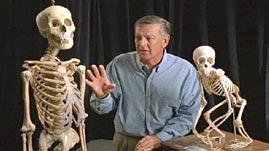The transition to upright walking that happened in the earliest stages of hominid evolution demanded a significant range of adaptations of the skeleton and muscles. But it was not quite as dramatic a transformation as it might at first appear. Almost all primates can sit upright, many can stand upright, and a few can even walk upright (although not for long, nor very efficiently). In other words, there has been a pattern in primate evolution of an upright body position -- whether clinging vertically to a tree trunk, leaping like a lemur, or swinging through the branches like an ape. The transition to bipedalism in hominids could build on this evolutionary pattern; it didn't require the direct transformation of a true quadruped like a horse into a committed biped.
There are important differences between the human skeleton and stride and that of our closest cousins, the chimpanzees, however. On the ground, chimpanzees use a characteristic gait called knuckle-walking, and although they can walk on two legs for short distances, their gait is not much like ours. Perhaps the most important difference is that chimps cannot extend their knees and lock their legs straight as humans can. Instead, they have to use muscle power to support their body weight when standing or walking upright, a much more tiring situation.
In humans, the thigh bone slopes inward from the hip to the knee, placing our feet under our center of gravity. We also have well-developed muscles (called gluteal abductors) on the side of our hips that contract to prevent our bodies toppling to one side when all our weight is on one foot in mid-stride. Chimps have thigh bones that do not slope inward to the knee like ours, so they stand and walk with their feet wide apart. Their gluteal abductors are also much weaker than ours, so they have to rock their whole body from side to side during each step, in order to move their center of gravity over whichever leg is bearing their weight.
Human bodies have a number of other adaptations to walking upright, as well. Our foot is specialized as a weight-bearing platform, with an arch that acts as a shock absorber. Our spines have a characteristic double curve, which brings our head and torso into a vertical line above our feet. The surfaces of the joints in our legs and between our vertebrae are enlarged, which is an advantage for bearing weight. And the hole through which the spinal cord enters the skull, called the foramen magnum, is near the center of the cranium in humans, allowing our heads to balance easily atop our spines rather than toward the back of the cranium as in chimps.
But we are by no means perfectly adapted to bipedal locomotion. Our spines are a heritage from distant ancestors who carried themselves horizontally, in water and on land. In those ancient creatures, as in modern quadrupeds, the spine functioned more like a flexible suspension bridge, supporting the body's organs -- a role to which it is structurally well suited. The human spine has been transformed into a weight bearing column, putting it under unprecedented stresses and dooming us to the likelihood of back injuries and pain.
As remarkable as our adaptations for bipedalism are, they are, like all evolutionary transformations, a compromise with history.


 Loading Standards
Loading Standards Teachers' Domain is proud to be a Pathways portal to the National Science Digital Library.
Teachers' Domain is proud to be a Pathways portal to the National Science Digital Library.
